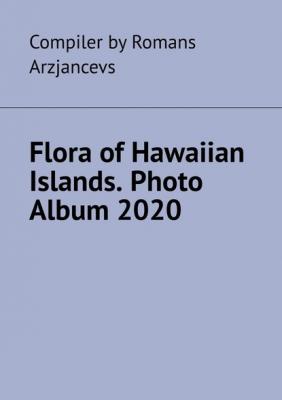Flora of Hawaiian Islands. Photo Album 2020. Romans Arzjancevs
Читать онлайн.| Название | Flora of Hawaiian Islands. Photo Album 2020 |
|---|---|
| Автор произведения | Romans Arzjancevs |
| Жанр | Биология |
| Серия | |
| Издательство | Биология |
| Год выпуска | 0 |
| isbn | 9785005148599 |
Compiler Romans Arzjancevs
ISBN 978-5-0051-4859-9
Created with Ridero smart publishing system
Compiler by ROMANS ARZJANCEVS
Compiler by ROMANS ARZJANCEVS
FLORA OF HAWAIIAN ISLANDS
PHOTO ALBUM
2020
USED SCIENTIFIC SOURCES:
1.https://en.wikipedia.org/wiki
2.http://nativeplants.hawaii.edu/plant/view
3.http://sarkive.com/plants-and-algae
4.http://www.hear.org/species
5.https://www.whykids.org/
6.https://www.florastore.com/en/plant-guide
7. https://en-gb.bakker.com/pages
8. https://www.aerifyplants.com/
BIG ISLAND OF HAWAII
RUBUS HAWAIENSIS
– It is found on the islands of Kaua’i, Moloka’i, Maui, O’ahu, and Hawai’i in mesic to wet forest at elevations of 600—3,070 m.
– ‘Akala translates to “pink’ in Hawaiian, the color of ‘ākala berry juice. The berries were used to dye kapa. Indeed, the berries are huge, especially when compared to other members of the Rubus genus. The berries are a little bitter.
– A scrambling native vine native to Hawai’i. Related to blackberry, this ‘ākala is the exception to the rule “native plants don’t have thorns”. It’s closer to sharp hairs than sharp thorns. And not all ‘ākala will have thorns, even in the same forest. It’s an unpleasant surprise when you touch an ‘ākala only to dig thorns out of your hand later. “Akala is somewhat deciduous, leaves are lost for a brief time in the winter.
WIKSTROEMIA SANDWICENSIS
– The species name sandwicensis refers to the «Sandwich Islands,» as the Hawaiian Islands were once called, and named by James Cook on one of his voyages in the 1770s. James Cook named the islands after John Montagu (The fourth Earl of Sandwich) for supporting Cook’s voyages.
– The fruits can be used in lei. Regarding the toxicity or lack thereof, How to Plant a Native Hawaiian Garden notes this: «In Hawaii, only the toxicity of Wikstroemia pulcherrima Skottb. has been studied extensively by Dr. Frank Tabrath. W. pulcherrima has caused mice to go to sleep. The toxicity of W. pulcherrima varies from high to zero toxicity even in the same plant at different times. Many people have eaten the berries for years without ill effects.»
– The largest species of akia, this can grow into a tree 30 feet tall, and can be hard to notice among other trees in the canopy. The young plants are distinctive with the large leaves and typical akia bark, but the mature trees have much smaller leaves and the bark usually gets covered in moss.
CANTHIUM ODORATUM
– Psydrax odorata, known as alahe’e in Hawaiian, is a species of flowering shrub or small tree in the coffee family, Rubiaceae. It is native to the Pacific Islands, New Guinea and Australia.
– The species range from 1.8—9.1 m in height, has a spread of 0.91—2.13 m, and a trunk width of up to 4 in (10 cm). The leaves are glossy green in colour, are up to 89 mm long and elliptic. The fruits of the plant are quite round, are black in colour and 3/8 wide.
– The fruits produce many seeds which are often attacked by the larvae of Orneodes objurgatella, a species of moth.
– Native Hawaiians used the very hard wood of alahe’e to make ko’i alahe’e (adzes for cutting softer woods such as Erythrina sandwicensis), ‘ō'ō (digging sticks), and ‘o (short spears). A black dye was made from the leaves.
PIPER METHYSTICUM
– Kava kava is a much-branched shrub growing up to 4 metres tall. The plant produces several stems 1 – 3cm in diameter from a large, thick, woody rhizome The plant is a herb with major ritual and cultural significance in the Pacific Islands where it is widely used in social ceremonies and as a means of communicating with the Gods Often harvested from the wild, it is also cultivated, especially in home gardens in the Pacific. The plant is commonly sold in local markets, and is also exported to Europe, America etc where it is used medicinally.
– The roots and stems are the source of a stimulating alkaloidal beverage called kawa that is widely consumed in some Polynesian Islands. It has a calming effect whilst also promoting mental clarity. The roots can weigh up to 7 kilos. To prepare the beverage, the plant parts are pulverized by grinding or mastication, suspended in water and then sieved to remove the residue. The resulting milky-brown liquid is the beverage.
– In Fiji, convulsions and stiffness in children are treated with liquid pressed from the leaves. The leaves are chewed as a treatment for bronchitis. Externally, the leaves are rubbed onto centipede bites, insect stings and stings from poisonous fish. The branches are used in a remedy for sore throats. An infusion of the leaves is spread onto a certain type of inflammation and is used to treat watery vaginal discharges.
MAUI
MAUI PLUMERIA
– Plumeria are not native to Hawaii. They were brought here in 1860 by a German botanist. The exotic, introduced flower thrived in Hawaii’s warm climate and volcanic soil, giving rise to the plethora of wonderful varieties born in Hawaii: the magnificent Royal Hawaiian, the deep crimson Hilo Beauty, and the sunset colored Lei Rainbow just to name a few.
– Few flowers hold the allure of Hawai’i more than the plumeria. The huge varieties found throughout the islands make it seem as though they originated here, but in truth they are an introduced species. First discovered in the southern forest regions of Mexico in the mid 1800’s, the plant is also known to indigenous to Central America, India, the Caribbean and Brazil.
– Plumeria have an amazing fragrance that is most intense at night as they lure moths needed to pollinate them. Interestingly enough they produce no nectar, effectively duping the pollinators to move from flower to flower in a fruitless search for nectar.
HIBISCUS
– Not
